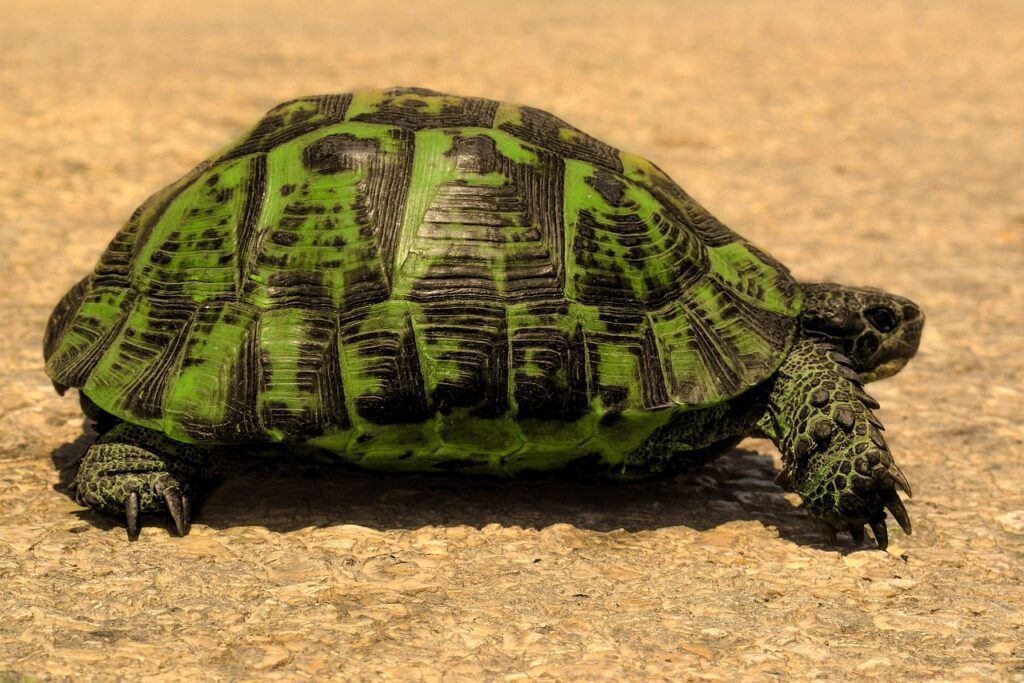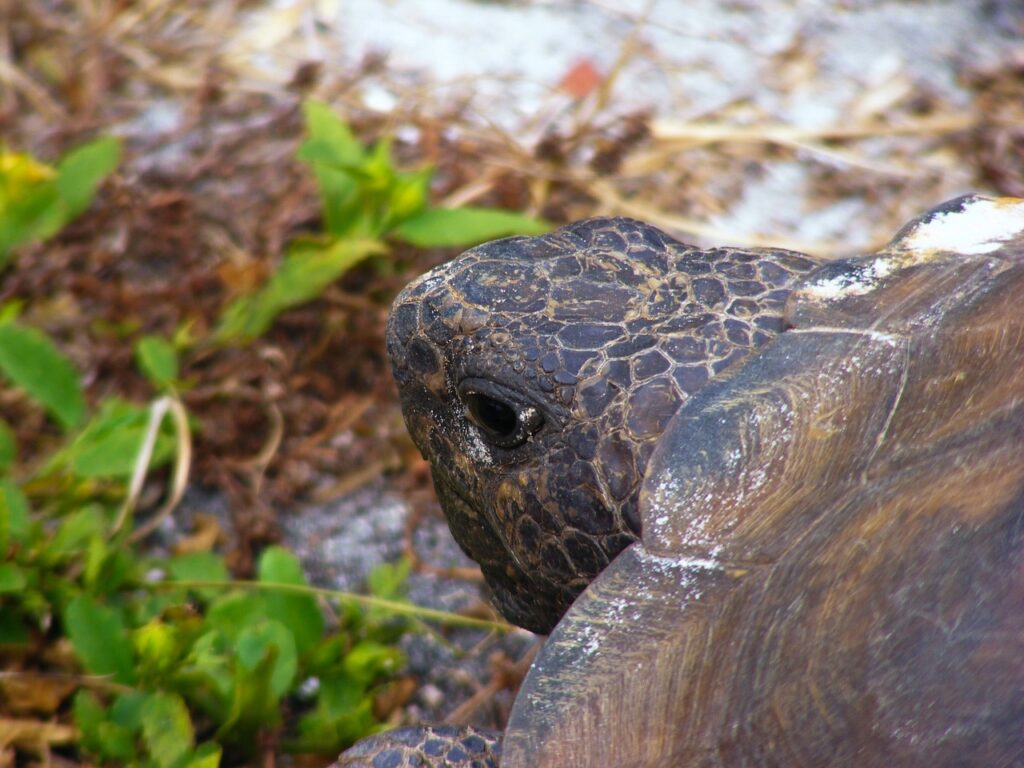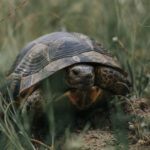Gopher tortoises are native to the southeastern US and have interesting appetites. These reptiles eat a variety of plants, such as grasses, legumes, and low-growing vegetation. Fruits, berries, and cacti are also consumed during certain months. This variety of food ensures they get the nourishment they need.
These tortoises are picky eaters and prefer certain types of plants, like wiregrass and saw palmetto berries. This selectiveness helps the ecosystems as they spread seeds through their droppings.
Let’s explore the strange story of Fred, a gopher tortoise. He had an odd diet that baffled biologists. Instead of the usual vegetation around his burrow, Fred preferred dandelions. Scientists studied the yellow flowers to investigate if they had any nutritional benefits.
Key Takeaways
- Gopher tortoises primarily eat plants, including grasses, legumes, and fruits.
- They have a specialized diet that includes a variety of vegetation to meet their nutritional needs.
- Gopher tortoises are considered herbivores and do not consume any animal products.
- Their diet can vary depending on the availability of food in their habitat.
- Gopher tortoises play a crucial role in their ecosystem by dispersing seeds and creating burrows that provide shelter for other animals.
General Overview of Gopher Tortoises

Gopher tortoises are interesting creatures found in the southeastern US. They have domed shells and strong claws, making nature lovers and scientists adore them. But what do they eat?
Grasses and legumes mainly, such as clover and tick trefoil. Fruits too, whenever they’re available. By having a varied diet, gopher tortoises get the nutrition they need and help to spread seeds.
Their burrows serve more than just protection. They regulate temperature and humidity in the area, which other animals can take refuge in during extreme weather or predators’ attacks.
Gopher tortoises are keystone species, influencing the composition of their habitats. When they decline due to destruction or fragmentation, it affects other organisms.
So, it’s important to protect these creatures and preserve their habitats. By supporting conservation efforts, we can help maintain the stability of our natural environment.
Knowing what gopher tortoises eat is essential, as you wouldn’t want them rummaging through your fridge for pizza rolls!
Importance of Knowing Their Diet
Knowing gopher tortoises’ dietary habits is hugely important to understand their part in the ecosystem and ensure they are well. Their diet affects not only them but the balance of their habitat too.
Grasses, legumes and other herbal plants form a major part of their diet. They help maintain vegetation structure and spread seeds, aiding plant growth. Plus, when fruits, berries and succulent plants are around, gopher tortoises will eat them as well. This lets them adapt to changing conditions in different seasons. So, even during hard times, they can stay nourished.
To show why understanding their diet is key, let me share a story about Tommy, a hungry gopher tortoise. On a harsh summer day, all plants were too dry to feed him. But then, Tommy spotted a meadow that had been recently watered by humans. There, he found plenty of lush greens to eat until his home was green again.
This proves how vital it is to comprehend gopher tortoises’ dietary needs. With this knowledge, we can make sure their habitats have all the right plants for them to eat in all seasons. Ultimately, understanding and meeting their nutrition needs helps them, and keeps the environment healthy too.
Factors Influencing Diet

Gopher tortoises have a diverse diet, influenced by various factors. To comprehend this, we must look at habitat, seasonal availability of food, and personal preference.
Habitat has a great effect on their diet. They live in sandy, dry areas with grasses, legumes, and broadleaf plants, which they feed on.
Seasonal changes also impact their diet. When there is no greenery, they rely on drought-resistant plants such as cacti and succulents. During rainy periods, they have access to more varieties of vegetation.
Furthermore, personal preference plays a part in what they consume. While they mainly eat plants and grasses, some may have a taste for certain types of vegetation.
Knowing these factors helps us understand the diverse diet of gopher tortoises and how they adapt to different conditions. The Florida Fish and Wildlife Conservation Commission (FWC) tell us that gopher tortoises mainly eat native vegetation like fruits, leaves, and flowers.
Natural Diet of Gopher Tortoises

Gopher Tortoises mainly consume grasses, legumes, and broadleaf weeds. Their diet also includes fruits, flowers, and succulent plant parts. This dietary habit helps disperse seeds and boosts plant growth, consequently maintaining ecological balance.
These reptiles have low protein needs due to their slow metabolic rate; this helps them survive in arid climates where food is scarce. Their ability to obtain nutrients from fibrous plants showcases their remarkable resilience and adaptability.
Behold the unique feeding habits of Gopher Tortoises. Watch them graze on grassy meadows or savor the colors of wildflowers. Nature’s beauty awaits you!
To further enrich the diet of Gopher Tortoises, try adding some leafy greens for a ‘Taco Tuesday’ twist!
Supplemental Feeding for Pet Gopher Tortoises
For a healthy gopher tortoise diet, remember to provide dark leafy greens and grasses daily. Occasional treats such as flowers or fruits can provide enrichment and variety. But don’t overfeed them! It’s also important to provide calcium and vitamin D3 supplements according to the vet’s instructions. A reptile specialist or vet can guide you in providing the right diet for your pet’s specific needs. Lastly, fast food and predators should not be part of the gopher tortoise’s diet!
Health Considerations
Gopher tortoises require special care. Here’s what to remember:
- Nutrition – It’s key for their well-being. They mainly eat grasses, legumes and succulent plants.
- Hydration – Provide them with clean water to avoid dehydration. They also get moisture from food.
- Habitat – Ensure suitable living conditions with enough space, correct temperature and humidity.
- Disease Prevention – Regular vet checks, vaccinations, parasite control and hygiene help.
- Protection from Predators – Keep gopher tortoises safe from cats, dogs and raccoons.
As a threatened species due to loss of habitat and poaching, conservation is vital. In 1987, the USFWS listed the eastern population as threatened to protect them and promote conservation.
By understanding their needs, we can contribute to their survival. Gopher tortoises have an appetite for success – even if that means weeds!
Frequently Asked Questions
Q: What do gopher tortoises eat?
A: Gopher tortoises primarily eat plants, such as grasses, legumes, and fruits.
Q: Can gopher tortoises eat meat?
A: No, gopher tortoises are herbivores and do not eat meat.
Q: Do gopher tortoises eat insects?
A: While insects can occasionally be a part of their diet, gopher tortoises primarily rely on vegetation for food.
Q: What are some specific plants that gopher tortoises eat?
A: Gopher tortoises commonly eat grasses, legumes (such as clover and peas), and a variety of fruits (including berries).
Q: Can gopher tortoises eat lettuce?
A: Yes, gopher tortoises can eat lettuce as part of their diet, but it should not be their sole food source.
Q: Are there any plants that are toxic to gopher tortoises?
A: Yes, some plants like azaleas, oleanders, and rhododendrons are toxic to gopher tortoises and should not be fed to them.
Conclusion
Gopher tortoises have a diverse diet. Grasses, legumes and broadleaf plants are the main foods. But, in certain seasons, cacti pads and fruit are consumed too. This adaptability helps them thrive in different habitats, making them essential to ecosystem health.
Their digestive system is special. Jaws are designed for grinding plants. In their intestines, fermentative bacteria aids digestion. This helps them extract maximum nutrition from their food. Plus, they spread seeds in their habitat.
Interesting fact: these tortoises dig tunnels into sandy soils. Shelters for them and other animals.
Be responsible observers. Respect their habitats. Keep your distance when encountering wildlife. Don’t offer human food or try to handle them. Give them space and freedom. Allow them to exist in harmony with their environment.
References




